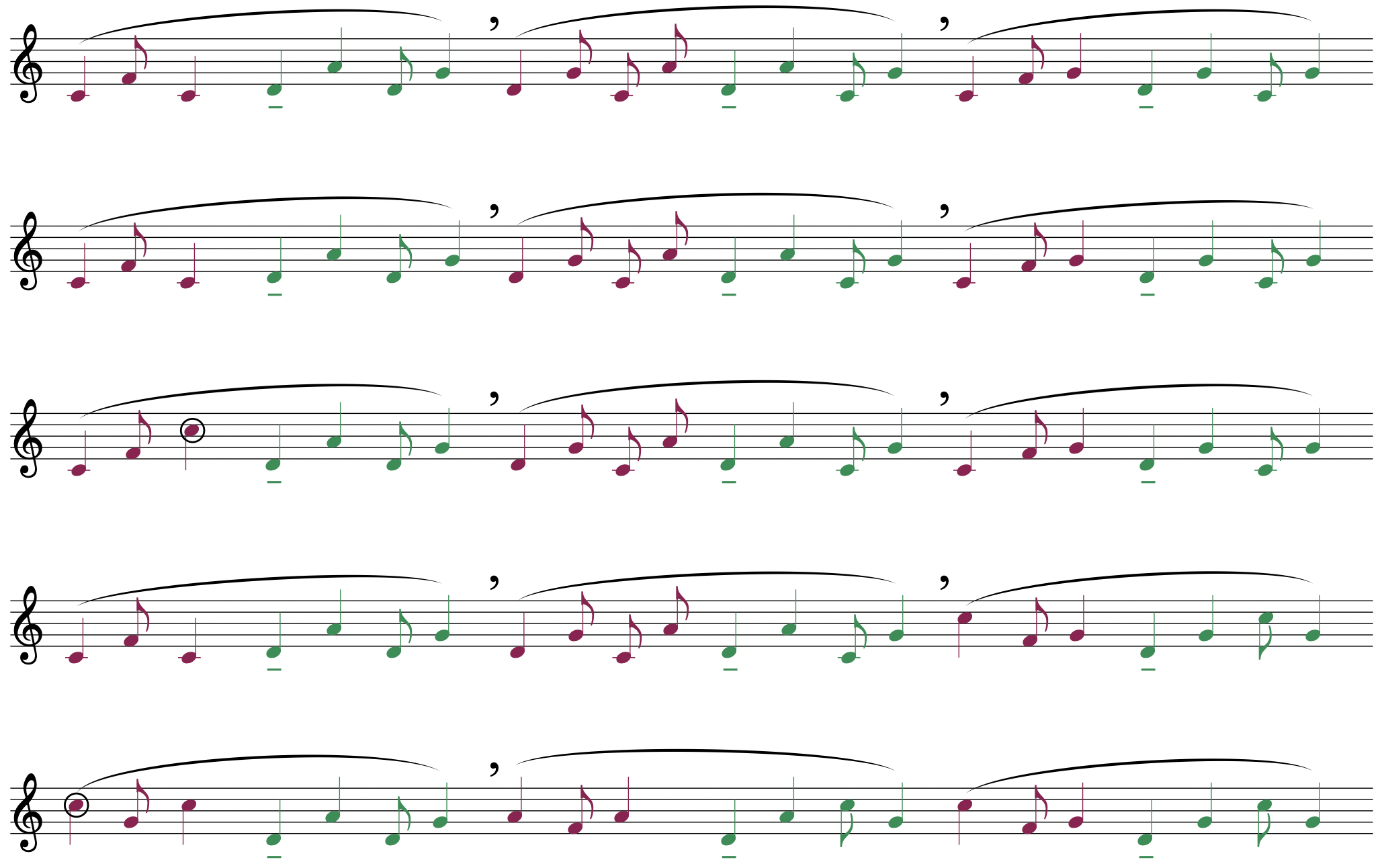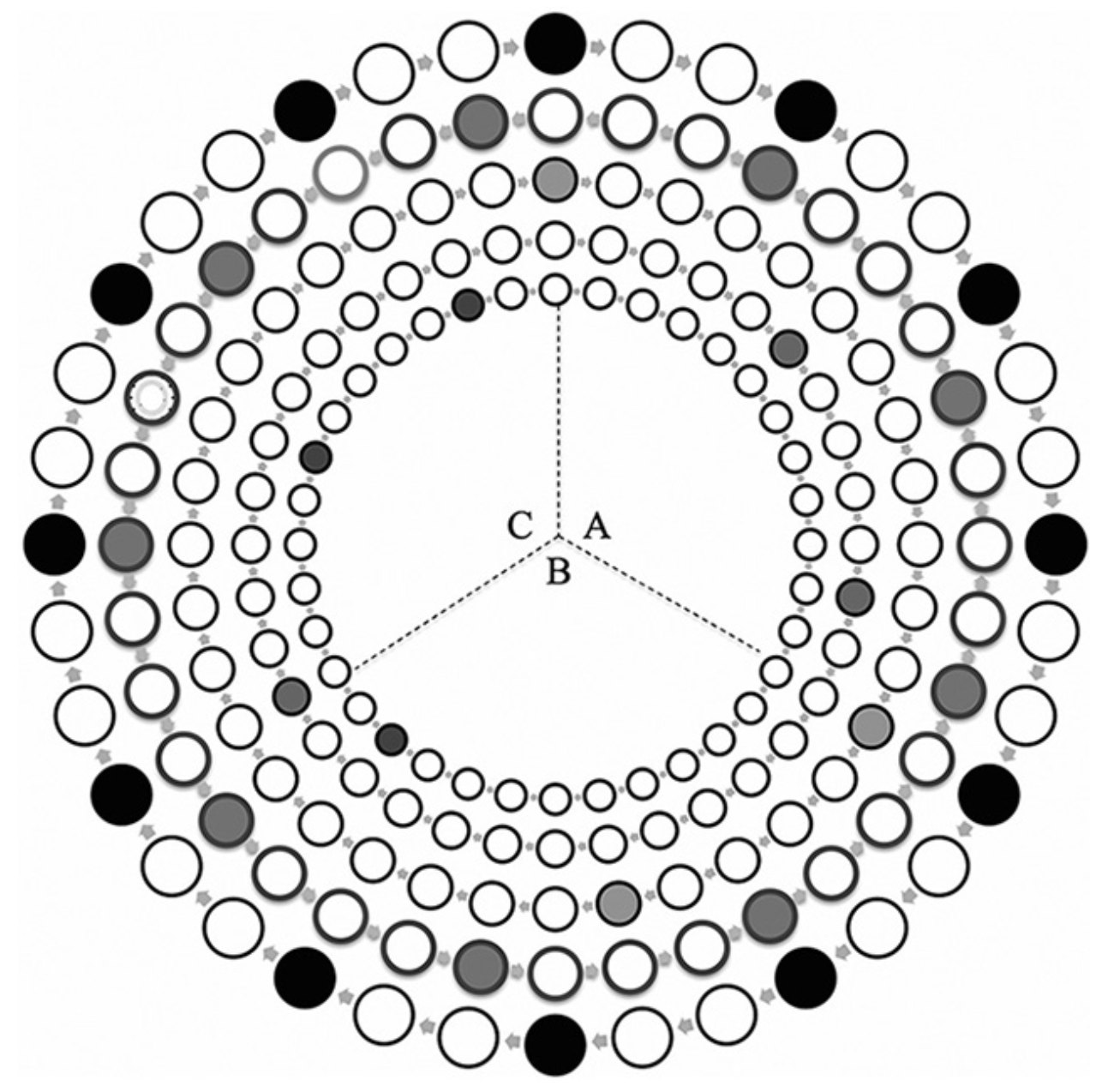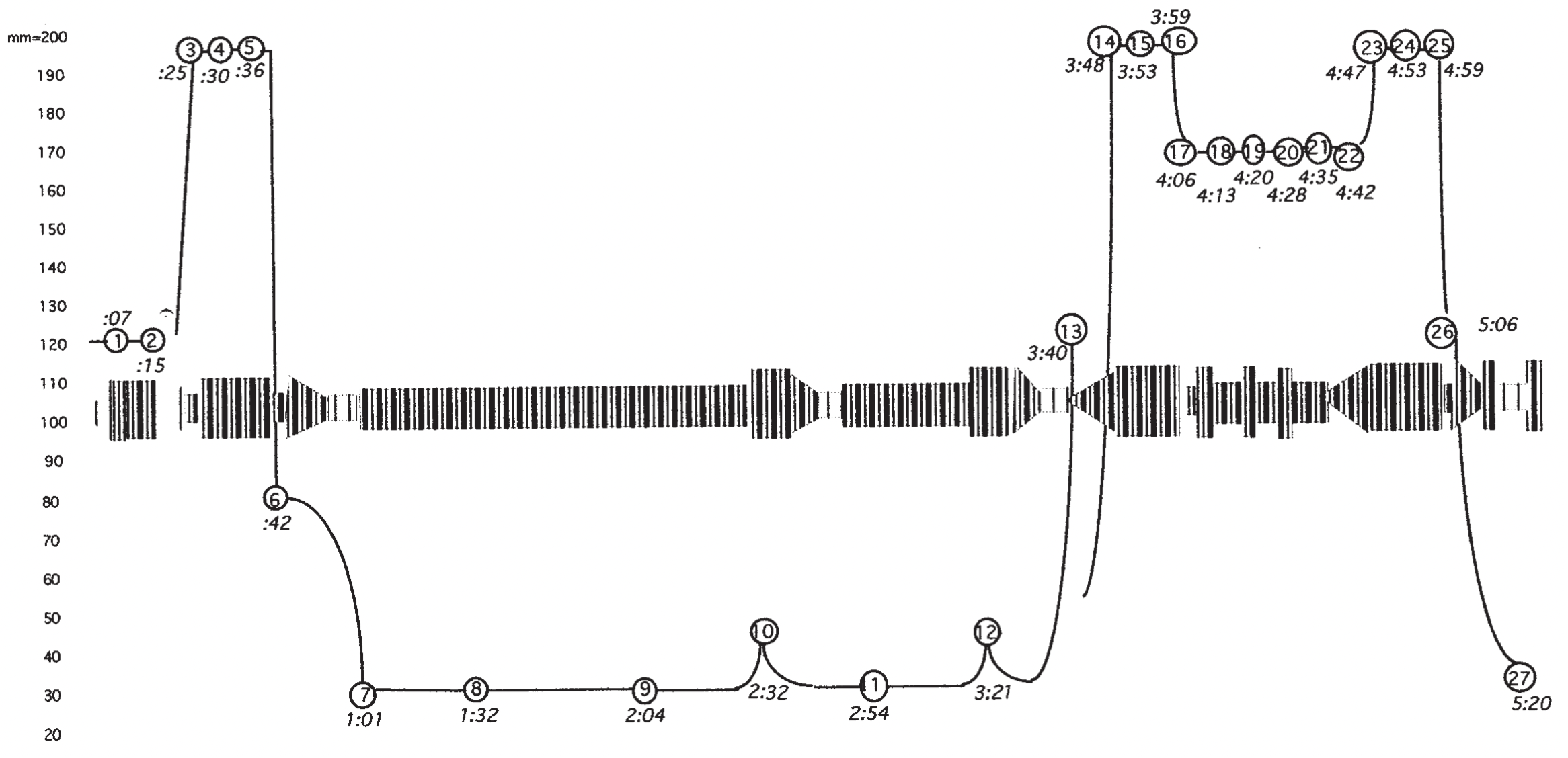On this page, we explore how visually representing musical cycles in various ways can enrich our understanding of them.
How can we visually represent cycles?
What do we learn by representing cycles in a visual format? What limitations does each visualisation have for our understanding of cyclic phenomena? Aural phenomena such as music are necessarily experienced in real time, but notation fixes this linear dimension in a static image that can be experienced non-linearly. Doing so affords us the opportunity to take in form as a whole and analyse the sound object in a way unconstrained by our memories. Specifically for the understanding of cycles, it is tempting to simply surround the material with repeat signs, but this does not accurately represent the way that we hear repetition. Repeat signs are more of an instruction than they are a description of our experiences of music featuring high degrees of repetition. Repetition is not simply a past event again, rather, a current event re-presents the features that make up the phenomenal experience we remember of a past event. Working against this high-level concern is the need for our visual representations to be succinct and readable, which, on top of our priorities of exploring and representing cycles in all their richness, is a challenging matter for the diverse repertories around the world that we are interested in.
Below are a few examples of ways we have represented cycles. Under each heading there is a short discussion of the advantages and disadvantages to each method. The musical examples are taken from various projects by different members of our research team.
5-Line staff transcriptions
Our research lies within the western academy, where 5-line staff notation is widely understood. This prevents more widespread communication, especially to many of the cultures (often oral traditions) whose music we study, for whom “western” notation is incomprehensible. Below is a simple transcription by Nathan Bernacki of a piece of Shop Diaphonic singing from Dyakovo, Bulgaria. For a quick overview of the basic form of the cycles of this piece, this is an effective tool that allows us to see that the notes remain essentially identical across the text verses.

Transcription of Tri Mi Zvezdi by Nathan Bernacki. Bold text shows stressed syllables.
However, there are nuances to each repetition of the cycle, especially in terms of the closeness of the intervals – the microtonal adjustments that the singers make to achieve the desired beating intensity. Timing is also not represented with high accuracy, nor does this show that there are very slight timing variations between verses. These changes are subtle, though, and so this transcription is more than enough for a quick glance while listening to the recording.
What happens when variations between cycles become so numerous that the idea of a “basic” form of the cycle, the paradigm, is hard to pinpoint?
Paradigmatic transcriptions
Below is an excerpt from a transcription by John Roeder of the solo “Yodel Etude” on the Ocora album Gabon – Musique des Pygmées Bibayak / Chantres de l’épopée, a set of recordings of the Bibayak Pygmies of the Gabonese rainforests released in 1989. Simha Arom refers to the kind of cyclicity present in this music as “ostinato with variations” (1991). The effect of this is “a kind of repetition where different phases of one iteration of the cycle can be understood to be analogous or even equivalent to the parallel phases of other iterations even when overt repetition is avoided” (Sawatzky 2021). To represent this in a staff transcription, writing each cycle directly underneath each other allows us to compare changes across repetitions of the cycle.

By representing it in this way, Roeder was able to bring out the nuances of the singer’s variations, noticing that there are directed changes across the performance. In this video, Roeder explains the formal processes present in the piece, and problematises the idea of a cycle template in this instance, where variations on a cycle are the primary formal development strategy.
TUBS Transcriptions
Not everyone who may be interested in the musical manifestations of cycles will necessarily be trained in reading the 5-line staff notation prevalent in the Western academy. Additionally, 5-line staff notation was invented for writing down Western art music, and thus it has built-in biases that make it easier to notate music that is conventional by Western standards, and the notation brings with it centuries of associated meanings (e.g. the beat weightings implied by time signatures). Many musics around the world have musical features that are not easily represented in 5-line staff notation, and when they are squeezed to fit into it, often elements of the music are lost.
One alternative to this is the Time-Unit Box System (TUBS). Each box represents a time-unit, usually the fastest pulse present in the music. An empty box is a rest, and boxes can be filled with any symbol to represent musical events. Such a score is most useful for representing rhythm, and in this way it is superior to staff notation because it can represent very complex rhythmic relationships and does so with neutrality regarding stress patterns. Additionally, it is somewhat self-explanatory, which may allow people not necessarily trained in music or any kind of notation to understand fairly quickly what a TUBS score represents. However, it is important to note that it implies an underlying isochronous pulse, which Rainer Polak has shown not to be necessary.
Below is a transcription of a South-Indian Konnakol composition which has 12 cycles each comprised of 75 pulses. Although this is possible to represent in staff notation using a time signature of say 75/16, the rhythmic relationships between the tāla and the vocalisations are obscured by staff notation – it is difficult to see how the rhythms align; and where the don’t align, precisely how.
[pdf view]
Additionally, the rhythmic processes of augmentation and diminution are very evident in this visualisation, and colours can easily be used to enrich the score and reveal processes in an engaging way. These can be generated through any spreadsheeting software program.
One criticism of TUBS is that it is not necessarily adept for transcription of pitch elements of music. However, with some creative workarounds, it is actually useful for representing music with fixed scales, especially those with a small number of notes per octave. Below is an excerpt Laura Crowe’s transcription of I Made Subandi’s Balinese gendér wayang composition ‘Aum‘.

Laura Crowe’s transcription of I Made Subandi’s ‘Aum’
Pitch is represented on the vertical axis. By using Balinese solfège for each box position, this has the advantage of being easily “transposable” to the wide variety of gendér tunings found in Bali, almost none of which can easily be “quantised” to fit into 12-tone equal temperament (12-TET). Additionally, whereas staff notation automatically implies the full gamut of 12-TET, this notation allows only the pitches available to these instruments to be focused on. Step-wise motion is much more clearly visible, and a discussion of how the affordances of the instrument affect the musical choices made can be more easily achieved.
Combination scores
TUBS and 5-line staff notation can be fairly easily combined to glean the advantages of each system. The fairly precise communication of pitch content to those trained in staff notation combined with TUBS’s more neutral approach to representing rhythm (without unnecessary overlaying time-signature conventions) can be seen in the following transcription. Michael Tenzer chose to represent ‘Hindehu’, a recording of nose flute and voice played by a pygmy from the Central-African Republic, in this way (see the article Transforming African Musical Cycles for a discussion of this piece).

Hindehu TUBS/staff score (the ‘D’ is the one nose flute pitch, the rest are sung)
Concentric Circles Diagrams
The nature of a cycle is one of return, recurrence, and repetition. All the representations shown up to this point have a linear organisation from left-to-right. But this linear orientation does not necessarily represent our experience of return that is a salient feature of listening to cyclic music. By arranging musical elements in a circle (sometimes called a clock diagram), our experience of return is more easily felt in such a visualisation. Below is Hindehu again, however, this time arranged in concentric circles, where each circle is a time-unit box. The outermost circles is the tenary tactus, a steady pulse not heard in the recording. Working inwards, the row of circles one step towards the centre of the circle is the nose flute pitch (approximately a D). The inner three circles are the three sung pitches (A, G, and F respectively).

Circular representation of “Hindehu”, a nose flute and vocal duet performed by a Ba-Benzélé pygmy from the Central African Republic
Arranged in this way, we can see how this paradigm form of Hindehu plays with the symmetry its 36-pulse cycle. What this visualisation doesn’t capture, and can’t easily without creating visual clutter, is the experience of cycles linearly. In this recording, there are small variations that are not shown in the above diagram. This is the case for many cycles across sub-Saharan Africa, where musicians improvise variations on the basic ostinato template/paradigm. Additionally, while we do experience return when we listen to cycles, our experience of them changes even if there are no variations; on a tenth repetition, we have built up expectations about the features of the cycle that we did not have on the first repetition.
Form Diagrams
Below is an example that does not try to represent actual notes/rhythms, but rather the experience of cycles in a linear context. Oleg Tumulilingan is from the Balinese dance genre legong, a musical style with a cyclic framework that is frequently disrupted by choreographic interruptions known as angsel, and with abrupt tempo and dynamic changes. In Michael Tenzer’s article on Oleg, he brings out these disruptions as a way of demonstrating that Balinese music, contrary to the common perceptions, is far from static. In the following diagram, each number represents one of the 27 gong strokes, which mark the end of a gongan (gong cycle). By laying these numbers out time proportionally, we can see that the way these cycles are spread out over the 5 and half minutes is very far from static – cycle durations are stretched and compressed, warping our temporal experience of them. As Tenzer points out, from the lowest speed present in this recording (~32BPM) to the fastest (~192BPM) is a 600% speed difference. In the centre of the graph is a bar showing dynamics, where a thicker region represents heightened dynamic intensity. Listen to this excerpt of Oleg here.

Graph of Tempo and Dynamics in Oleg Tamulilingan
Reference List
Tenzer, Michael. 2017. “Transforming African Musical Cycles.” Music Theory Spectrum 39: 139-157.

